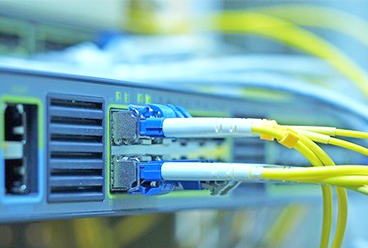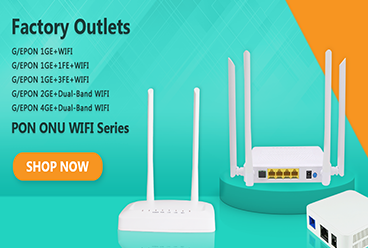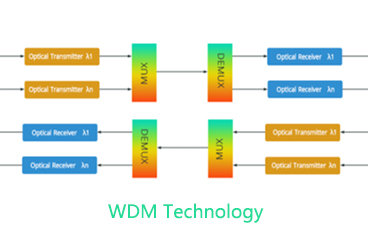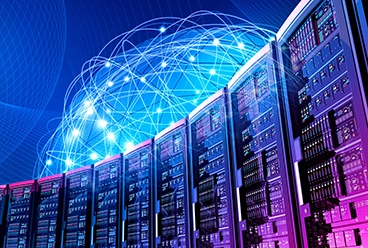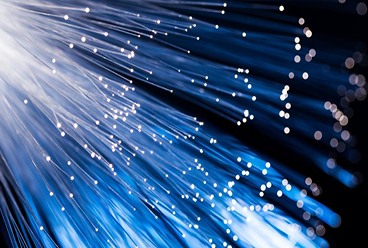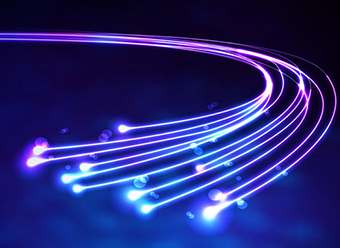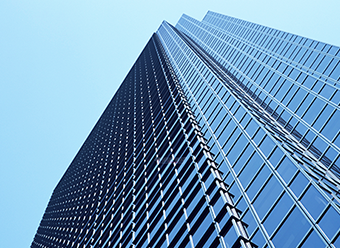Fiber optic deployment in Data Center is one of the core trends for future development. By adopting advanced fiber optic products such as 100G/400G/800G optical transceivers, MTP/MPO multi-fiber connectors, and DWDM technology, Data Center can meet the ever-growing bandwidth demands.
Detailed Introduction of Fiber Optic Products for Data Center
1. Single-Mode Fiber (SMF)
Features: Single-mode fiber (SMF) is suitable for long-distance transmission, with a smaller core diameter. It typically operates at 1310nm and 1550nm wavelengths, supporting long-distance low-loss data transmission up to 100 kilometers.
Applications: Mainly used in long-distance backbone networks between Data Center.
Advantages: Ideal for high-bandwidth, low-attenuation applications, especially for 100G, 400G, and higher-speed networks.
2. Multimode Fiber (MMF)
Features: Multimode fiber (MMF) is commonly used for high-bandwidth short-distance applications, operating at 850nm wavelength. Common types include OM3, OM4, and OM5 fibers, which support high-speed short-distance transmission.
Applications: Suitable for interconnection between devices within a data center.
Advantages: Cost-effective for short-distance deployments, especially for connections between servers and switches.
3. Optical Transceivers
25G SFP28 Optical Transceiver
Features: The 25G SFP28 is a common optical module used for short-distance connections in data centers, supporting a data rate of 25Gbps. It is typically used for connections between servers and Top of Rack (TOR) switches. SFP28 modules are compact, have low power consumption, and are easy to integrate.
Applications: Suitable for internal data center cabling, especially in high-performance computing and storage networks.
Advantages: Supports higher data transmission rates and is backward compatible with existing 10G infrastructure, making upgrades easier.
40G QSFP+ Optical Transceiver
Features: The 40G QSFP+ module supports parallel data transmission with 4 channels of 10Gbps each, totaling 40Gbps. It is commonly used for short-distance multimode fiber connections, ideal for high-speed interconnection between data center switches.
Applications: Used in core or aggregation layers of data centers, suitable for applications that require higher bandwidth.
Advantages: Offers flexible connectivity through breakout cables, providing 40G to 4x10G connections, making it an ideal choice for transitioning from 10G to 40G networks.
100G/400G Optical Transceivers (QSFP28, QSFP-DD)
Features: 100G and 400G optical modules are the mainstream modules for data center interconnection. They use PAM4 modulation and WDM technology to support ultra-high-speed data transmission, meeting the bandwidth demands of core switches and storage networks.
Applications: Commonly used for core switches and long-distance data center interconnections.
Advantages: High bandwidth and low latency, supporting seamless upgrades to higher-speed networks.
800G Optical Transceivers
Features: 800G optical modules are designed to meet the ultra-high bandwidth demands of emerging technologies like AI, big data, and 5G. They utilize PAM4 modulation technology to provide 8x100G parallel transmission capabilities.
Applications: Suitable for backbone networks in hyperscale data centers and high-performance computing applications.
Advantages: Capable of handling bandwidth growth for the next few years, providing seamless scalability.
4. High-Speed Cables (DAC/AOC)
Direct Attach Copper Cable (DAC)
Features: DAC cables are short-distance high-speed cables commonly used for direct interconnection between switches and servers. They support speeds of 10G, 25G, 40G, 100G, etc. DAC cables are available in passive and active types, with active DACs (Active DAC) integrating signal amplifiers to extend transmission distance.
Applications: Suitable for short-distance interconnection within or between adjacent racks in data centers, with a typical transmission distance of less than 10 meters.
Advantages: Low cost, low power consumption, and reliable, especially for short-distance high-bandwidth scenarios.
Active Optical Cable (AOC)
Features: AOC is a fiber-optic cable integrated with optical-electrical conversion modules, supporting long-distance high-speed data transmission. It is commonly used in 40G, 100G, and higher bandwidth scenarios. Compared to DAC, AOC supports longer transmission distances, typically up to 100 meters or more.
Applications: Used for high-speed connections between servers and switches, particularly in data center cabling where longer transmission distances are required.
Advantages: Provides longer transmission distances and better signal quality than DAC, making it suitable for medium to long-distance high-bandwidth connections.
5. Fiber Optic Patch Cords and Connectors
LC/SC/FC Connectors
Features: LC connectors are small and high-density, widely used in data centers; SC and FC connectors are also used in specific scenarios, providing reliable fiber optic connections.
Applications: Mainly used for fiber optic patch cord connections, supporting short-distance interconnections between devices.
Advantages: Compact design and high reliability, ideal for high-density fiber optic connection applications.
MTP/MPO Connectors
Features: MTP/MPO is a multi-fiber connector that supports high-density parallel fiber transmission, suitable for large-scale data centers.
Applications: High-speed network applications for parallel optical transmission, especially in scenarios that require rapid expansion and upgrades.
Advantages: Enables fast deployment and efficient scalability, supporting future bandwidth growth.
6. Fiber Optic Patch Panels and Cabinets
Modular Patch Panels
Features: Modular patch panels allow for terminal management and organization of fiber optic cables, flexibly supporting network upgrades and expansions.
Applications: Used for fiber optic cable management in data centers.
Advantages: Improves cabling efficiency and future flexibility.
High-Density Cabinets
Features: Provides solutions for supporting a large number of fiber optic connections in limited space, optimizing space utilization in data centers.
Applications: Suitable for modern data centers that require high-density fiber optic connections.
Advantages: Supports high-density fiber management through a compact design, ensuring organized cabling.
Trends in Data Center Fiber Optic Products
Widespread Adoption of 25G, 40G, and 100G Transceivers: As server and switch bandwidths increase, 25G SFP28 and 40G QSFP+ modules are widely used in data centers. 25G is becoming the next-generation standard, compatible with existing 10G networks, offering high cost-performance and enabling seamless upgrades to 100G. Meanwhile, 40G QSFP+ continues to play a key role in large-scale deployments, especially for high-density, short-distance interconnections.
Smooth Transition from 100G to 400G and 800G: Data centers are transitioning from 100G to 400G and 800G networks, with growing market demand for higher data rates. As bandwidth needs increase, 400G QSFP-DD and 800G modules are becoming essential products to meet future data flow requirements.
Diverse Demand for High-Speed Cables (DAC and AOC): As the demand for short-distance high-speed connections between servers and switches grows, the use of high-speed cables (especially DAC and AOC) is expanding. AOC’s advantage in long-distance transmission and low power consumption is increasingly favored in internal data center cabling, particularly in scenarios requiring flexible deployment.
High-Density Trend of MTP/MPO Multi-Fiber Connectors: As the demand for fiber optic port density increases, the use of MTP/MPO multi-fiber connectors in data centers is growing rapidly. They provide efficient parallel optical connections, supporting high-bandwidth applications, and are especially suitable for future high-density cabling environments.
Sopto Technology is a fiber optic product manufacturer and supplier that can provide one-stop service for Data Center Solution. If you are interested, please feel free to contact us.
Tags : Data Center, Optical Transceivers , Fiber cable, 100G QSFP28, DAC/AOC, Fiber Optic Patch Cords
— END —




